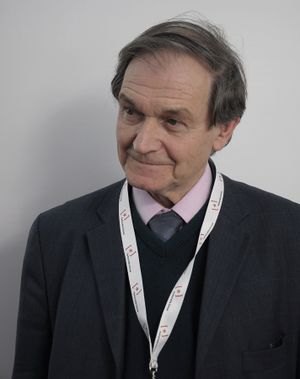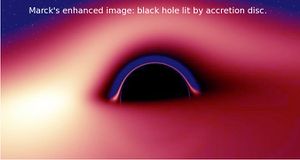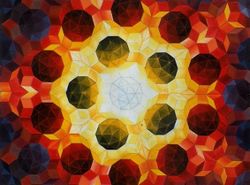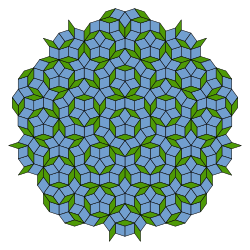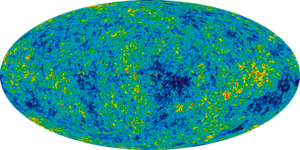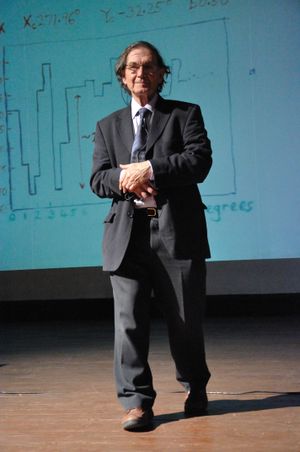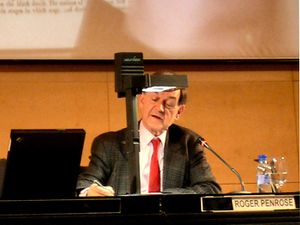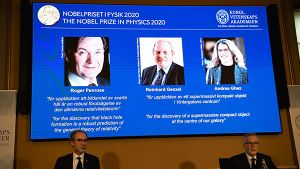روجر پنروز
السير روجر پنروز OM FRS (و. 8 أغسطس 1931)، هو فيزيائي رياضي ورياضي وفيلسوف علوم إنگليزي. وهو أستاذ روس بول للرياضيات في جامعة إكسفورد، زميل فخري في كلية وادام، أكسفورد، وزميل فخري في كلية سانت جون، كمبردج.
قدم پنروز اسهامات بارزة في الفيزياء الرياضية للنسبية العامة وعلم الكون. حصل على العديد من الجوائز والتكريمات، من بينها جائزة وولف في الفيزياء 1988، التي تشاركها مع ستيفن هوكنگ من أجل نظريات تفرد پنروز-هوكنگ، وجائزة نوبل في الفيزياء 2020 "لاكتشافه أن تشكل الثقب الأسود هو تنبؤ قوى لنظرية النسبية العامة"[1]، والتي حازها مناصفة مع ريناهرد گنزل وأندريا گيز لاكتشافهما جسماً مضغوطاً فائق الكتلة في مركز مجرة درب التبانة.[2]
. . . . . . . . . . . . . . . . . . . . . . . . . . . . . . . . . . . . . . . . . . . . . . . . . . . . . . . . . . . . . . . . . . . . . . . . . . . . . . . . . . . . . . . . . . . . . . . . . . . . . . . . . . . . . . . . . . . . . . . . . . . . . . . . . . . . . . . . . . . . . . . . . . . . . . . . . . . . . . . . . . . . . . . .
السنوات المبكرة والحياة الأكاديمية
Born in Colchester, Essex, Roger Penrose is a son of psychiatrist and geneticist Lionel Penrose and Margaret Leathes,[أ] and the grandson of the physiologist John Beresford Leathes and his wife, a Russian Jew, Sonia Marie Natanson,[3][4] who had left St. Petersburg in the late 1880s.[5] His uncle was artist Roland Penrose, whose son with photographer Lee Miller is Antony Penrose. Penrose is the brother of physicist Oliver Penrose and of chess Grandmaster Jonathan Penrose. Penrose attended University College School and University College, London, where he graduated with a first class degree in mathematics. In 1955, while still a student, Penrose reintroduced the E. H. Moore generalised matrix inverse, also known as the Moore–Penrose inverse,[6] after it had been reinvented by Arne Bjerhammar in 1951. Having started research under the professor of geometry and astronomy, Sir W. V. D. Hodge, Penrose finished his PhD at St John's College, Cambridge in 1958, with a thesis on "tensor methods in algebraic geometry" under algebraist and geometer John A. Todd. He devised and popularised the Penrose triangle in the 1950s, describing it as "impossibility in its purest form", and exchanged material with the artist M. C. Escher, whose earlier depictions of impossible objects partly inspired it. Escher's Waterfall, and Ascending and Descending were in turn inspired by Penrose.[بحاجة لمصدر]
As reviewer Manjit Kumar puts it:
As a student in 1954, Penrose was attending a conference in Amsterdam when by chance he came across an exhibition of Escher's work. Soon he was trying to conjure up impossible figures of his own and discovered the tribar [see tri-bar for an image] – a triangle that looks like a real, solid three-dimensional object, but isn't. Together with his father, a physicist and mathematician, Penrose went on to design a staircase that simultaneously loops up and down. An article followed and a copy was sent to Escher. Completing a cyclical flow of creativity, the Dutch master of geometrical illusions was inspired to produce his two masterpieces.[7]
Having become a reader at Birkbeck College, London (and having had his attention drawn from pure mathematics to astrophysics by the cosmologist Dennis Sciama, then at Cambridge) it was in 1964 that, in the words of Kip Thorne of Caltech, "Roger Penrose revolutionised the mathematical tools that we use to analyse the properties of spacetime". Until then work on the curved geometry of general relativity had been confined to configurations with sufficiently high symmetry for Einstein's equations to be soluble explicitly, and there was doubt about whether such cases were typical. One approach to this issue was by the use of perturbation theory, as developed under the leadership of John Archibald Wheeler at Princeton. The other, more radically innovative, approach initiated by Penrose was to overlook the detailed geometrical structure of spacetime and instead concentrate attention just on the topology of the space, or at most its conformal structure, since it is the latter – as determined by the lay of the lightcones – that determines the trajectories of lightlike geodesics, and hence their causal relationships. The importance of Penrose's epoch-making paper "Gravitational collapse and space-time singularities"[8] was not only its result (roughly that if an object such as a dying star implodes beyond a certain point, then nothing can prevent the gravitational field getting so strong as to form some kind of singularity). It also showed a way to obtain similarly general conclusions in other contexts, notably that of the cosmological Big Bang, which he dealt with in collaboration with Dennis Sciama's most famous student, Stephen Hawking.[بحاجة لمصدر]
It was in the local context of gravitational collapse that the contribution of Penrose was most decisive, starting with his 1969 cosmic censorship conjecture, to the effect that any ensuing singularities would be confined within a well-behaved event horizon surrounding a hidden space-time region for which Wheeler coined the term black hole, leaving a visible exterior region with strong but finite curvature, from which some of the gravitational energy may be extractable by what is known as the Penrose process, while accretion of surrounding matter may release further energy that can account for astrophysical phenomena such as quasars.[بحاجة لمصدر]
Following up his "weak cosmic censorship hypothesis", Penrose went on, in 1979, to formulate a stronger version called the "strong censorship hypothesis". Together with the BKL conjecture and issues of nonlinear stability, settling the censorship conjectures is one of the most important outstanding problems in general relativity. Also from 1979 dates Penrose's influential Weyl curvature hypothesis on the initial conditions of the observable part of the universe and the origin of the second law of thermodynamics.[9] Penrose and James Terrell independently realised that objects travelling near the speed of light will appear to undergo a peculiar skewing or rotation. This effect has come to be called the Terrell rotation or Penrose–Terrell rotation.[10][11]
In 1967, Penrose invented the twistor theory which maps geometric objects in Minkowski space into the 4-dimensional complex space with the metric signature (2,2).[بحاجة لمصدر]
Penrose is well known for his 1974 discovery of Penrose tilings, which are formed from two tiles that can only tile the plane nonperiodically, and are the first tilings to exhibit fivefold rotational symmetry. Penrose developed these ideas based on the article Deux types fondamentaux de distribution statistique[12] (1938; an English translation Two Basic Types of Statistical Distribution) by Czech geographer, demographer and statistician Jaromír Korčák. In 1984, such patterns were observed in the arrangement of atoms in quasicrystals.[13] Another noteworthy contribution is his 1971 invention of spin networks, which later came to form the geometry of spacetime in loop quantum gravity. He was influential in popularising what are commonly known as Penrose diagrams (causal diagrams).[بحاجة لمصدر]
In 1983, Penrose was invited to teach at Rice University in Houston, by the then provost Bill Gordon. He worked there from 1983 to 1987.[14]
النشاط اللاحق
الكون المبكر
الفيزياء والوعي
| جزء من سلسلة عن |
| علم الكون الطبيعي |
|---|
|
Penrose has written books on the connection between fundamental physics and human (or animal) consciousness. In The Emperor's New Mind (1989), he argues that known laws of physics are inadequate to explain the phenomenon of consciousness. Penrose proposes the characteristics this new physics may have and specifies the requirements for a bridge between classical and quantum mechanics (what he calls correct quantum gravity). Penrose uses a variant of Turing's halting theorem to demonstrate that a system can be deterministic without being algorithmic. (For example, imagine a system with only two states, ON and OFF. If the system's state is ON when a given Turing machine halts and OFF when the Turing machine does not halt, then the system's state is completely determined by the machine; nevertheless, there is no algorithmic way to determine whether the Turing machine stops.)[بحاجة لمصدر]
Penrose believes that such deterministic yet non-algorithmic processes may come into play in the quantum mechanical wave function reduction, and may be harnessed by the brain. He argues that computers today are unable to have intelligence because they are algorithmically deterministic systems. He argues against the viewpoint that the rational processes of the mind are completely algorithmic and can thus be duplicated by a sufficiently complex computer. This contrasts with supporters of strong artificial intelligence, who contend that thought can be simulated algorithmically. He bases this on claims that consciousness transcends formal logic because things such as the insolubility of the halting problem and Gödel's incompleteness theorem prevent an algorithmically based system of logic from reproducing such traits of human intelligence as mathematical insight. These claims were originally espoused by the philosopher John Lucas of Merton College, Oxford.[بحاجة لمصدر]
The Penrose–Lucas argument about the implications of Gödel's incompleteness theorem for computational theories of human intelligence has been widely criticised by mathematicians, computer scientists and philosophers, and the consensus among experts in these fields seems to be that the argument fails, though different authors may choose different aspects of the argument to attack.[15] Marvin Minsky, a leading proponent of artificial intelligence, was particularly critical, stating that Penrose "tries to show, in chapter after chapter, that human thought cannot be based on any known scientific principle." Minsky's position is exactly the opposite – he believed that humans are, in fact, machines, whose functioning, although complex, is fully explainable by current physics. Minsky maintained that "one can carry that quest [for scientific explanation] too far by only seeking new basic principles instead of attacking the real detail. This is what I see in Penrose's quest for a new basic principle of physics that will account for consciousness."[16]
Penrose responded to criticism of The Emperor's New Mind with his follow up 1994 book Shadows of the Mind, and in 1997 with The Large, the Small and the Human Mind. In those works, he also combined his observations with that of anesthesiologist Stuart Hameroff.
Penrose and Hameroff have argued that consciousness is the result of quantum gravity effects in microtubules, which they dubbed Orch-OR (orchestrated objective reduction). Max Tegmark, in a paper in Physical Review E,[17] calculated that the time scale of neuron firing and excitations in microtubules is slower than the decoherence time by a factor of at least 10,000,000,000. The reception of the paper is summed up by this statement in Tegmark's support: "Physicists outside the fray, such as IBM's John A. Smolin, say the calculations confirm what they had suspected all along. 'We're not working with a brain that's near absolute zero. It's reasonably unlikely that the brain evolved quantum behavior'".[18] Tegmark's paper has been widely cited by critics of the Penrose–Hameroff position.
In their reply to Tegmark's paper, also published in Physical Review E, the physicists Scott Hagan, Jack Tuszyński and Hameroff[19][20] claimed that Tegmark did not address the Orch-OR model, but instead a model of his own construction. This involved superpositions of quanta separated by 24 nm rather than the much smaller separations stipulated for Orch-OR. As a result, Hameroff's group claimed a decoherence time seven orders of magnitude greater than Tegmark's, but still well short of the 25 ms required if the quantum processing in the theory was to be linked to the 40 Hz gamma synchrony, as Orch-OR suggested. To bridge this gap, the group made a series of proposals.[بحاجة لمصدر]
They supposed that the interiors of neurons could alternate between liquid and gel states. In the gel state, it was further hypothesized that the water electrical dipoles are oriented in the same direction, along the outer edge of the microtubule tubulin subunits. Hameroff et al. proposed that this ordered water could screen any quantum coherence within the tubulin of the microtubules from the environment of the rest of the brain. Each tubulin also has a tail extending out from the microtubules, which is negatively charged, and therefore attracts positively charged ions. It is suggested that this could provide further screening. Further to this, there was a suggestion that the microtubules could be pumped into a coherent state by biochemical energy.
Finally, he suggested that the configuration of the microtubule lattice might be suitable for quantum error correction, a means of holding together quantum coherence in the face of environmental interaction.[بحاجة لمصدر]
Hameroff, in a lecture in part of a Google Tech talks series exploring quantum biology, gave an overview of current research in the area, and responded to subsequent criticisms of the Orch-OR model.[21] In addition to this, a 2011 paper by Roger Penrose and Stuart Hameroff published in the fringe Journal of Cosmology gives an updated model of their Orch-OR theory, in light of criticisms, and discusses the place of consciousness within the universe.[22]
Phillip Tetlow, although himself supportive of Penrose's views, acknowledges that Penrose's ideas about the human thought process are at present a minority view in scientific circles, citing Minsky's criticisms and quoting science journalist Charles Seife's description of Penrose as "one of a handful of scientists" who believe that the nature of consciousness suggests a quantum process.[18]
In January 2014 Hameroff and Penrose claimed that a discovery of quantum vibrations in microtubules by Anirban Bandyopadhyay of the National Institute for Materials Science in Japan[23] confirms the hypothesis of Orch-OR theory.[24] A reviewed and updated version of the theory was published along with critical commentary and debate in the March 2014 issue of Physics of Life Reviews.[25]
حياته الشخصية
. . . . . . . . . . . . . . . . . . . . . . . . . . . . . . . . . . . . . . . . . . . . . . . . . . . . . . . . . . . . . . . . . . . . . . . . . . . . . . . . . . . . . . . . . . . . . . . . . . . . . . . . . . . . . . . . . . . . . . . . . . . . . . . . . . . . . . . . . . . . . . . . . . . . . . . . . . . . . . . . . . . . . . . .
العائلة
آراؤه الدينية
جوائز وتكريمات
في 6 أكتوبر 2020، أعلنت الأكاديمية الملكية السويدية للعلوم عن الفائزين بجائزة نوبل في الفيزياء 2020. وقد منحت الجائزة مناصفة بين روجر پنروز "لاكتشافه أن تشكل الثقب الأسود هو تنبؤ قوى لنظرية النسبية العامة"[26]، وريناهرد گنزل وأندريا گيز لاكتشافهما جسماً مضغوطاً فائق الكتلة في مركز مجرة درب التبانة.[27]
أعماله
منشورات بارزة
- The Emperor's New Mind: Concerning Computers, Minds, and The Laws of Physics (1989)
- Shadows of the Mind: A Search for the Missing Science of Consciousness (1994)
- The Road to Reality: A Complete Guide to the Laws of the Universe (2004)
- Cycles of Time: An Extraordinary New View of the Universe (2010)
- Fashion, Faith, and Fantasy in the New Physics of the Universe (2016)
كاتب مشارك
- The Nature of Space and Time (with Stephen Hawking) (1996)
- The Large, the Small and the Human Mind (with Abner Shimony, Nancy Cartwright, and Stephen Hawking) (1997)
- White Mars: The Mind Set Free (with Brian Aldiss) (1999)
كتب أكاديمية
- Techniques of Differential Topology in Relativity (1972, ISBN 0-89871-005-7)
- Spinors and Space-Time: Volume 1, Two-Spinor Calculus and Relativistic Fields (with Wolfgang Rindler, 1987) ISBN 0-521-33707-0 (paperback)
- Spinors and Space-Time: Volume 2, Spinor and Twistor Methods in Space-Time Geometry (with Wolfgang Rindler, 1988) (reprint), ISBN 0-521-34786-6 (paperback)
مقدمات كتب أخرى
- Foreword to “The Map and the Territory: Exploring the foundations of science, thought and reality” by Shyam Wuppuluri and Francisco Antonio Doria. Published by Springer in "The Frontiers Collection", 2018.
- Foreword to Beating the Odds: The Life and Times of E. A. Milne, written by Meg Weston Smith. Published by World Scientific Publishing Co in June 2013.
- Foreword to "A Computable Universe" by Hector Zenil. Published by World Scientific Publishing Co in December 2012.
- Foreword to Quantum Aspects of Life by Derek Abbott, Paul C. W. Davies, and Arun K. Pati. Published by Imperial College Press in 2008.
- Foreword to Fearful Symmetry by Anthony Zee's. Published by Princeton University Press in 2007.
انظر أيضاً
الهوامش
- ^ Penrose and his father shared mathematical concepts with Dutch graphic artist M. C. Escher which were incorporated into a lot of pieces, including Waterfall, which is based on the 'Penrose triangle', and Up and Down.
المصادر
- ^ "The Nobel Prize in Physics 2020". NobelPrize.org (in الإنجليزية الأمريكية). Retrieved 2020-10-06.
- ^ "تعرف على الفائزين بجائزة نوبل في الفيزياء لعام 2020". البوابة نيوز. 2020-10-06. Retrieved 2020-10-06.
- ^ Brookfield, Tarah (2018-10-15). Our Voices Must Be Heard: Women and the Vote in Ontario (in الإنجليزية). UBC Press. ISBN 978-0-7748-6022-2.
- ^ Rudolph Peters (1958). "John Beresford Leathes. 1864–1956". Biographical Memoirs of Fellows of the Royal Society. 4: 185–191. doi:10.1098/rsbm.1958.0016.
- ^ Roger Penrose. Cycles of Time: Is It Possible to Discern the Previous Universe Through the Big Bang? at YouTube
- ^ Penrose, R. (1955). "A generalized inverse for matrices". Mathematical Proceedings of the Cambridge Philosophical Society. 51 (3): 406–413. Bibcode:1955PCPS...51..406P. doi:10.1017/S0305004100030401.
- ^ Kumar, Manjit (15 October 2010). "Cycles of Time: An Extraordinary New View of the Universe by Roger Penrose – review". The Guardian.
- ^ Penrose, Roger (January 1965). "Gravitational Collapse and Space-Time Singularities". Physical Review Letters. 14 (3): 57–59. Bibcode:1965PhRvL..14...57P. doi:10.1103/PhysRevLett.14.57.
- ^ R. Penrose (1979). "Singularities and Time-Asymmetry". S. W. Hawking General Relativity: An Einstein Centenary Survey: 581–638, Cambridge University Press.
- ^ Terrell, James (1959). "Invisibility of the Lorentz Contraction". Physical Review. 116 (4): 1041–1045. Bibcode:1959PhRv..116.1041T. doi:10.1103/PhysRev.116.1041.
- ^ Penrose, Roger (1959). "The Apparent Shape of a Relativistically Moving Sphere". Proceedings of the Cambridge Philosophical Society. 55 (1): 137–139. Bibcode:1959PCPS...55..137P. doi:10.1017/S0305004100033776.
- ^ Jaromír Korčák (1938): Deux types fondamentaux de distribution statistique. Prague, Comité d'organisation, Bull. de l'Institute Int'l de Statistique, vol. 3, pp. 295–299.
- ^ Steinhardt, Paul (1996). "New perspectives on forbidden symmetries, quasicrystals, and Penrose tilings". PNAS. 93 (25): 14267–14270. Bibcode:1996PNAS...9314267S. doi:10.1073/pnas.93.25.14267. PMC 34472. PMID 8962037.
- ^ "Roger Penrose at Rice, 1983–87". Rice History Corner. 22 May 2013.
- ^
Criticism of the Lucas/Penrose argument that intelligence can not be entirely algorithmic:
- MindPapers: 6.1b. Godelian arguments
- References for Criticisms of the Gödelian Argument
- Boolos, George, et al. 1990. An Open Peer Commentary on The Emperor's New Mind. Behavioral and Brain Sciences 13 (4) 655.
- Davis, Martin 1993. How subtle is Gödel's theorem? More on Roger Penrose. Behavioral and Brain Sciences, 16, 611–612. Online version at Davis' faculty page at http://cs.nyu.edu/cs/faculty/davism/
- Feferman, Solomon (1996). "Penrose's Gödelian argument". Psyche: An Interdisciplinary Journal of Research on Consciousness. 2: 21–32. CiteSeerX 10.1.1.130.7027.
- Krajewski, Stanislaw 2007. On Gödel's Theorem and Mechanism: Inconsistency or Unsoundness is Unavoidable in any Attempt to 'Out-Gödel' the Mechanist. Fundamenta Informaticae 81, 173–181. Reprinted in Topics in Logic, Philosophy and Foundations of Mathematics and Computer Science:In Recognition of Professor Andrzej Grzegorczyk (2008), p. 173
- LaForte, Geoffrey; Hayes, Patrick J.; Ford, Kenneth M. (1998). "Why Gödel's Theorem Cannot Refute Computationalism". Artificial Intelligence. 104 (1–2): 265–286. doi:10.1016/s0004-3702(98)00052-6.[dead link]
- Lewis, David K. 1969. Lucas against mechanism. Philosophy 44 231–233.
- Putnam, Hilary 1995. Review of Shadows of the Mind. In Bulletin of the American Mathematical Society 32, 370–373 (also see Putnam's less technical criticisms in his New York Times review)
- Bringsford, S. and Xiao, H. 2000. A Refutation of Penrose's Gödelian Case Against Artificial Intelligence. Journal of Experimental and Theoretical Artificial Intelligence 12: 307–329. The authors write that it is "generally agreed" that Penrose "failed to destroy the computational conception of mind."
- In an article at "King's College London – Department of Mathematics". Archived from the original on 25 January 2001. Retrieved 22 October 2010. L.J. Landau at the Mathematics Department of King's College London writes that "Penrose's argument, its basis and implications, is rejected by experts in the fields which it touches."
- Princeton Philosophy professor John Burgess writes in On the Outside Looking In: A Caution about Conservativeness (published in Kurt Gödel: Essays for his Centennial, with the following comments found on pp. 131–132) that "the consensus view of logicians today seems to be that the Lucas–Penrose argument is fallacious, though as I have said elsewhere, there is at least this much to be said for Lucas and Penrose, that logicians are not unanimously agreed as to where precisely the fallacy in their argument lies. There are at least three points at which the argument may be attacked."
- Nachum Dershowitz 2005. The Four Sons of Penrose, in Proceedings of the Eleventh Conference on Logic for Programming, Artificial Intelligence and Reasoning (LPAR; Jamaica), G. Sutcliffe and Andrei Voronkov, eds., Lecture Notes in Computer Science, vol. 3835, Springer-Verlag, Berlin, pp. 125–138.
- ^ Marvin Minsky. "Conscious Machines." Machinery of Consciousness, Proceedings, National Research Council of Canada, 75th Anniversary Symposium on Science in Society, June 1991.
- ^ Tegmark, Max (2000). "The importance of quantum decoherence in brain processes". Physical Review E. 61 (4): 4194–4206. arXiv:quant-ph/9907009. Bibcode:2000PhRvE..61.4194T. doi:10.1103/physreve.61.4194. PMID 11088215. S2CID 17140058.
- ^ أ ب Tetlow, Philip (2007). The Web's Awake: An Introduction to the Field of Web Science and the Concept of Web Life. Hoboken, New Jersey: John Wiley & Sons. p. 166. ISBN 978-0-470-13794-9.
- ^ Hagan, S.; Hameroff, S.; Tuszyński, J. (2002). "Quantum Computation in Brain Microtubules? Decoherence and Biological Feasibility". Physical Review E. 65 (6): 061901. arXiv:quant-ph/0005025. Bibcode:2002PhRvE..65f1901H. doi:10.1103/PhysRevE.65.061901. PMID 12188753. S2CID 11707566.
{{cite journal}}: Unknown parameter|last-author-amp=ignored (|name-list-style=suggested) (help) - ^ Hameroff, S. (2006). "Consciousness, Neurobiology and Quantum Mechanics". In Tuszynski, Jack (ed.). The Emerging Physics of Consciousness. Springer. pp. 193–253. Bibcode:2006epc..book.....T.
- ^ "Clarifying the Tubulin bit/qubit – Defending the Penrose-Hameroff Orch OR Model (Quantum Biology)". YouTube. 22 October 2010. Retrieved 13 August 2012.
- ^ Roger Penrose; Stuart Hameroff (4 July 1992). "Consciousness in the Universe: Neuroscience, Quantum Space-Time Geometry and Orch OR Theory". Journal of Cosmology. Quantumconsciousness.org. Archived from the original on 16 June 2012. Retrieved 13 August 2012.
{{cite journal}}: Unknown parameter|last-author-amp=ignored (|name-list-style=suggested) (help) - ^ "Anirban Bandyopadhyay". Retrieved 22 February 2014.
- ^ "Discovery of quantum vibrations in 'microtubules' inside brain neurons supports controversial theory of consciousness". ScienceDaily. Retrieved 22 February 2014.
- ^ S. Hameroff; R. Penrose (2014). "Consciousness in the universe: A review of the 'Orch OR' theory". Physics of Life Reviews. 11 (1): 39–78. Bibcode:2014PhLRv..11...39H. doi:10.1016/j.plrev.2013.08.002. PMID 24070914.
- ^ "The Nobel Prize in Physics 2020". NobelPrize.org (in الإنجليزية الأمريكية). Retrieved 2020-10-06.
- ^ "تعرف على الفائزين بجائزة نوبل في الفيزياء لعام 2020". البوابة نيوز. 2020-10-06. Retrieved 2020-10-06.
. . . . . . . . . . . . . . . . . . . . . . . . . . . . . . . . . . . . . . . . . . . . . . . . . . . . . . . . . . . . . . . . . . . . . . . . . . . . . . . . . . . . . . . . . . . . . . . . . . . . . . . . . . . . . . . . . . . . . . . . . . . . . . . . . . . . . . . . . . . . . . . . . . . . . . . . . . . . . . . . . . . . . . . .
قراءات إضافية
- Ferguson, Kitty (1991). Stephen Hawking: Quest for a Theory of Everything. Franklin Watts. ISBN 0-553-29895-X.
- Misner, Charles; Thorne, Kip S.; Wheeler, John Archibald (1973). Gravitation. San Francisco: W. H. Freeman. ISBN 978-0-7167-0344-0.
{{cite book}}: Unknown parameter|last-author-amp=ignored (|name-list-style=suggested) (help) (See Box 34.2.)
وصلات خارجية
- روجر پنروز at the Internet Movie Database
- Awake in the Universe - Penrose debates how creativity, the most elusive of faculties, has helped us unlock the country of the mind and the mysteries of the cosmos with Bonnie Greer.
- Dangerous Knowledge at YouTube – Penrose was one of the principal interviewees in a BBC documentary about the mathematics of infinity directed by David Malone
- Penrose's new theory "Aeons Before the Big Bang?":
- Original 2005 lecture: "Before the Big Bang? A new perspective on the Weyl curvature hypothesis" (Isaac Newton Institute for Mathematical Sciences, Cambridge, 11 November 2005).
- Original publication: "Before the Big Bang: an outrageous new perspective and its implications for particle physics". Proceedings of EPAC 2006. Edinburgh. 2759–2762 (cf. also Hill, C.D. & Nurowski, P. (2007) "On Penrose's 'Before the Big Bang' ideas". Ithaca)
- Revised 2009 lecture: "Aeons Before the Big Bang?" (Georgia Institute of Technology, Center for Relativistic Astrophysics)
- BBC interview on the new theory at YouTube
- Roger Penrose on The Forum
- Penrose on sidestepping reason at YouTube
- O'Connor, John J.; Robertson, Edmund F., "روجر پنروز", MacTutor History of Mathematics archive
- Hilary Putnam's review of Penrose's 'Shadows of the Mind' claiming that Penrose's use of Godel's Incompleteness Theorem is fallacious
- Beyond the Doubting of a Shadow: A Reply to Commentaries on Shadows of the Mind at the Wayback Machine (archived 18 يونيو 2008)
- Penrose Tiling found in Islamic Architecture
- Two theories for the formation of quasicrystals resembling Penrose tilings
- Tegmark, Max (2000). "The importance of quantum decoherence in brain processes". Physical Review E. 61 (4): 4194–4206. arXiv:quant-ph/9907009. Bibcode:2000PhRvE..61.4194T. doi:10.1103/physreve.61.4194. PMID 11088215. S2CID 17140058.
- "Biological feasibility of quantum states in the brain" – (a disputation of Tegmark's result by Hagan, Hameroff, and Tuszyński)
- "Toilet Paper Plagiarism" at the Wayback Machine (archived 12 مارس 2005) – D. Trull about Penrose's lawsuit concerning the use of his Penrose tilings on toilet paper
- Roger Penrose: A Knight on the tiles (Plus Magazine)
- Penrose's Gifford Lecture biography
- Quantum-Mind
- Audio: Roger Penrose in conversation on the BBC World Service discussion show
- Roger Penrose speaking about Hawking's new book on Premier Christian Radio
- "The Cyclic Universe – A conversation with Roger Penrose", Ideas Roadshow, 2013
- Forbidden crystal symmetry in mathematics and architecture, filmed event at the Royal Institution, October 2013
- Oxford Mathematics Interviews: "Extra Time: Professor Sir Roger Penrose in conversation with Andrew Hodges." These two films explore the development of Sir Roger Penrose’s thought over more than 60 years, ending with his most recent theories and predictions. 51 min and 42 min. (Mathematical Institute)
- BBC Radio 4 – The Life Scientific – Roger Penrose on Black Holes – 22 November 2016 Sir Roger Penrose talks to Jim Al-Khalili about his trailblazing work on how black holes form, the problems with quantum physics and his portrayal in films about Stephen Hawking.
- The Penrose Institute Website
- A chess problem holds the key to human consciousness?, Chessbase
- CS1 الإنجليزية الأمريكية-language sources (en-us)
- Articles with dead external links from December 2017
- CS1 errors: unsupported parameter
- مواليد 8 أغسطس
- مواليد 1931
- شهر الميلاد مختلف في ويكي بيانات
- يوم الميلاد مختلف في ويكي بيانات
- مقالات ذات عبارات بحاجة لمصادر
- Pages using sidebar with the child parameter
- رياضياتيون إنگليز
- دراسات الوعي
- علماء كونيات
- زملاء الجمعية الملكية
- إنسانيون إنگليز
- كتاب علوم إنگليز
- مستلمو وسام ألبرت أنشتاين
- خريجو جامعة كمبردج
- خريجو جامعة كلية لندن
- أشخاص مرتبطون بكلية جامعة لندن
- أكاديميو جامعة لندن
- زملاء جامعة أكسفورد
- أعضاء مرتبة الاستحقاق
- حائزو جائزة وولف في الفيزياء
- حائزو جائزة آدمز
- إنسانيون بريطانيون
- Erdős number 3
- فرسان بريطانيون
- أشخاص أحياء
- طاقم تدريس جامعة ولاية پنسلڤانيا
- حائزو جائزة نوبل في الفيزياء
- حائزو جائزة نوبل بريطانيون

